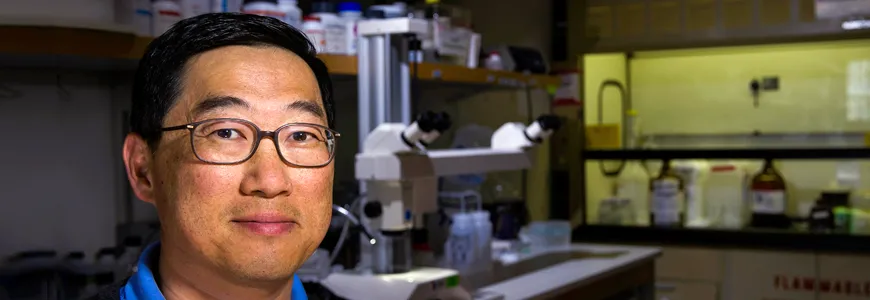
Photo by Steve Fisch: Analyzing human pancreatic tissue, rather than relying on animal models, helped Seung Kim and his colleagues better understand how the organ's function changes as we age.
Stanford Medicine News Center - April 28th, 2016 - by Krista Conger
Age-related changes in the human pancreas govern how our bodies respond to rising and falling blood sugar levels throughout our lifetimes, and could affect whether we develop diabetes as adults. But it’s been nearly impossible to study this process in detail because human pancreatic tissue is not readily available.
Instead, most researchers have relied on animal models to learn more about the development and function of the pancreas.
Now researchers at the Stanford University School of Medicine have for the first time compared the patterns of gene expression in the insulin-producing cells and other cells of the pancreas from dozens of deceased donors ranging in age from 6 months to 66 years. They found significant differences in gene expression patterns and DNA modifications between donors under the age of 9 and those older than 28.
The findings, published April 28 in Cell Metabolism, highlight the importance of two genes not previously implicated directly in pancreatic function, and show that the pancreas continues to develop and mature during the first decades of life. They may also have implications for current clinical trials testing stem-cell-based therapies for diabetes.
“Studying human islet cells has been a major challenge in the field of diabetes research for decades because the pancreas essentially digests itself shortly after a person’s death,” said professor of developmental biology Seung Kim, MD, PhD. “We’ve developed a nationwide network capable of removing and studying pancreatic tissue from organ donors as young as 6 months and as old as 66 within about a day and half after death. This gave us an unprecedented opportunity to chart changes in gene expression spanning the course of a lifetime.”
Kim is the senior author of the study. Postdoctoral scholar Efsun Arda, PhD, is the lead author.
“This study is a tour de force,” said Andrew Stewart, MD, the director of the Diabetes, Obesity and Metabolism Institute at the Mount Sinai School of Medicine who is unconnected with the study. “It is very important to the field of diabetes research.”
How islet cells mature
In the study, Kim, Arda and their colleagues identified two proteins never before directly implicated in pancreatic function whose expression increases as a person ages. Increasing the expression of one of the proteins, SIX3, in the insulin-producing cells isolated from younger donors enhanced their ability to respond efficiently to rising glucose levels.
“Pancreatic islets, which are the sites of insulin production, mature and change in their function after a baby is born,” said Kim. “We think our findings suggest that this maturation process goes on for nearly a decade. There’s been a growing realization among diabetes researchers that human islet development differs significantly from islet development in typical laboratory animals like mice.”
Cells in the pancreatic islets called beta cells are responsible for modulating the body’s response to the rise and fall of blood glucose levels after a meal. When glucose levels rise, the beta cells release insulin to cue cells throughout the body to squirrel away the sugar for later use. Type 1 diabetes is caused by a failure to produce insulin; Type 2 diabetes is caused by combined deficits in the body to respond to and make insulin. Both types have been linked to reductions in the number of insulin-producing beta cells.
Although beta cells proliferate robustly during the first decade or so of life, this proliferation slows dramatically with age. Understanding the age-related signals that cause this slowdown could one day lead to new diabetes treatments. But something more significant than the changes in cell number is also going on. Studies in rodents and in human fetal beta cells have showed that the responses of very young beta cells to increases in blood glucose are blunted when compared to their more-mature counterparts.
Sorting the cells
Kim and his colleagues worked for over six years to develop a multi-institutional collaboration to quickly collect pancreatic tissue and isolate and analyze islet cells from newly deceased donors. They also developed a unique cell-sorting technique to isolate islet cells from other cells in the pancreas. Once they had pure populations of cells, they compared their patterns of gene expression, as well as changes in the structure of the DNA.
“We identified hundreds of genes that are dynamically regulated in islet beta cells during the journey from childhood to adulthood,” said Kim. “One gene, SIX3, turns on sometime around age 9. We wondered whether its expression might change the function of the beta cell.” Forcing the expression of SIX3 in beta cells obtained from children under the age of 9 improved the ability of the cells to secrete insulin in the presence of glucose, the researchers found.
SIX3 and a related gene, SIX2, with a similar pattern of expression in human beta cells, encode proteins known as transcription factors that control the expression of many other genes in the cell. Although they have not been implicated directly in pancreatic function, genomewide association studies have linked the presence of a mutation near the genes to an impaired ability to properly manage fasting blood-glucose levels.
“This is a tantalizing link,” said Kim. “It appears that genes whose expression changes from childhood to adulthood may be disproportionately associated with an increased risk for diabetes.”
Only in humans
Importantly, SIX3 and SIX2 are not expressed in mouse beta cells.
“This is why it is so important to study human tissue,” said Kim. “Until now there has been no way of knowing the gradual changes that happen over a period of years.”
Kim and his colleagues are planning to continue their studies of pancreatic and islet-cell development as part of a Stanford focus on diabetes and metabolism research. The researchers also anticipate that their gene expression data and newly described islet-cell isolation technique, coupled with the ongoing tissue procurement effort, will be helpful to others studying pancreatic development and diabetes.
“This is a unique and valuable resource for researchers wishing to begin to understand how gene expression is dynamically regulated in human islet cells,” said Kim. “Our study charts a new road map for researchers working to use stem cells to replace human islet cells by highlighting changes that normally occur and should perhaps be taken into consideration when analyzing cells for transplant.”
The team’s work is an example of Stanford Medicine’s focus on precision health, the goal of which is to anticipate and prevent disease in the healthy and precisely diagnose and treat disease in the ill.
The study was funded by JDRF, the National Institutes of Health (grants 5T32DK007217, UO1DK089532, DK72473, DK89572, DK104211 and DK20593), the Department of Veterans Affairs, the Vanderbilt Diabetes Research and Training Center, the Helmsley Charitable Trust, the H.L. Snyder Foundation, the Elser Foundation, the Doolittle Trust and the Howard Hughes Medical Institute.
The project grew out of the NIH-funded Beta Cell Biology Consortium. Kim and his colleagues are members of a new consortium named the Human Pilot Resource Network that recognizes the importance of studying human tissues.
Other Stanford co-authors of the study include postdoctoral scholars Lingyu Li, PhD, and Heshan Peiris, PhD; former postdoctoral scholar Robert Spitale, PhD; data scientist Jennifer Tsai; former life sciences research assistant Eduardo Torre; life sciences research assistants Yenny Rosli and Jing Wang; research assistant Xueying Gu; senior bioinformatics scientist Kun Qu, PhD; professor of genetics Michael Snyder, PhD; and professor of dermatology Howard Chang, MD, PhD.
Stanford’s Department of Developmental Biology also supported the work.



